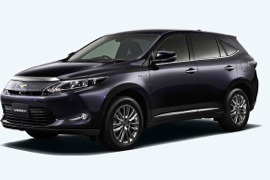TOYOTA Harrier Models/Series Timeline, Specifications & Photos
First production year: 2014
Engines: Gasoline, Hybrid gasoline
Body style: SUV (Sports Utility Vehicle)
Toyota introduced in 2017 a mid-life cycle refresh for the 2013 Harrier, a Japan-only re-badged Lexus RX.
The Japanese carmaker launched the Harrier's first generation in 1997 and kept it on the market for six years before it unveiled the second generation. Toyota rushed to improved it, and after just five years, it added important technological and safety features.
From the design point of view, there were several changes to the car. At the front, it sported a different badge than the rest of its stablemates, with an eagle head instead of the Toyota logo. Its grille was almost completely covered on the upper side, with only a narrow and wide gap underneath, above the bumper. An additional cooling area for the lower-mounted radiators found its place in the bumper. The angular-looking headlights with sharp corners and curved upper and lower sides created an aggressive image for the compact-sized SUV. At the back, the raked-forward tailgate sported a spoiler at the upper side.
Inside, the Harrier featured a leather-clad interior. It wasn't at the same quality level as the premium RX model, but it was close. Its instrument cluster featured two dials that flanked a TFT screen between them for the onboard computer. On the center stack, a large infotainment touch-screen display featured the Entune Toyota system.
Under the skin, the Harrier offered a choice of gasoline and hybrid drivetrains with either a front or all-wheel-drive system. It didn't provide the same wide powerplants options like the Lexus RX, but it had what it takes to get to its customer hearts and wallets.
